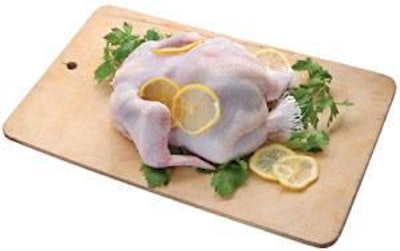
A cross-section of U.S. residents were asked about their chicken-eating habits, covering both their home preparation and outside purchases, in the survey conducted by PKS Research Partners.
One thousand and four interviews were conducted with people 18 years of age or older, in June 2007. Six hundred sixty-nine (67 percent) of respondents were primary grocery shoppers, 70 (7 percent) shared shopping responsibilities, and the remaining 245 (25 percent) were not responsible for shopping.
Interviewees were asked to base their responses on their eating habits in the prior two weeks and their purchasing habits in the prior four weeks.
The 2007 survey results show a slight decline in chicken consumption when compared with the 2006 survey. This decline coincides with the broiler industry's small cutback in production which began in the fourth quarter of 2006. and continued into the first two quarters of 2007. This production cutback reduced supply of chicken meat and served to move prices for chicken up. This increase in chicken prices has been passed on to consumers and has likely reduced demand somewhat.
Twenty key survey findings are listed here:
Total chicken consumption
1. 91 percent ate a meal or snack that contained chicken in the two weeks prior to the survey, a slight drop from 92 percent reported in 2006.
On average, respondents had eaten chicken 4.5 times, down from the 2006 (5.2 times). Respondents between the ages of 25 - 34 reported eating the highest number of meals or snacks that contained chicken (5.9 times) followed by those 18-24 (4.8 times) and those 35 - 64 (4.4 times).
2. Higher (over $50,000) and lower (under $30,000) income respondents ate more chicken than those within the middle income range, 5.1 times and 4.6 times respectively. Respondents with an income of $30,000 to less than $50,000 consumed chicken most frequently in 2006.
3. Regionally there is little variation in the proportion of respondents who ate one or more meals or snacks that contained chicken. Consumption does not drop below 86 percent in any region of the country. In line with 2006 findings, respondents in the South and West ate the highest number of chicken meals or snacks.
Chicken purchased at a grocery store
4. 82 percent of respondents ate chicken purchased at a grocery store within the two weeks, down 5 percent from 2006.
The decrease in purchase is most clearly seen among frequent buyers. Less than one-sixth (17 percent) of the sample said they had eaten chicken from a grocery store five or more times versus 24 percent in 2006. Respondents less than 65 years old were more likely to have eaten chicken from a grocery store more frequently.
5. Higher income respondents ($75,000 or more) ate more chicken at 3.2 times.
Lower income respondents averaged 2.6 times.
6. Midwesterners ate significantly less chicken purchased at a grocery store. 21 percent said they had not eaten chicken purchased at a grocery store compared to 16 percent negative responses from respondents in other regions.
7. Households that have two or more people are significantly more likely to have eaten more meals that contained chicken from a supermarket or grocery store (85 percent vs. 69 percent). Larger households average 2.7 meals while one person households average 2.5 meals.
Chicken purchased at food service
8. Two out of three respondents (65 percent) had eaten one or more chicken meals purchased at a food service. On average, the respondents had eaten nearly two meals (1.8) with chicken outside of their home. This is in line with the 67 percent and 1.6 times reported in 2006.
9. Women eat more chicken outside of the home then men. Nine percent of women ate chicken outside of the home five or more times in the two week period compared to 6 percent of men.
10. Respondents over 65 years old ate chicken out less frequently (1.2 times) than younger respondents (2.0 times). The 65 and over group eating chicken out dropped from the 2006 level of 57 percent to 49 percent.
11. Lower income households, $20,000 - $29,000, are the most likely (74 percent) to have eaten one or more chicken meals out. Those earning $30,000 - $39,999 are the least likely (51 percent).
Rotisserie habits
12. 23 percent of the respondents purchased rotisserie chicken in four weeks prior to the survey. 25 - 34 year olds are the least likely to have made the purchase (16 percent).
13. Respondents with an income of $75,000 or more are the most likely purchasers of rotisserie chicken (31 percent). Those with an income of $30,000 to $39,999 are the least likely to purchase (16 percent).
14. Shoppers from 25 - 49 years old were most likely to purchase rotisserie chicken from a takeout restaurant or foodservice (59 percent). Those 65 years of age and older were the least likely (40 percent).
15. More rotisserie chicken was purchased in the west (30 percent) in the four weeks prior to the survey. Other regions: south 25 percent; northeast 22 percent, and midwest 17 percent.
16. Heavy users purchased more rotisserie chicken outside the home in the four weeks prior to the survey (30 percent versus 16 percent). An average of 2.7 rotisserie chickens were purchased with 1.7 bought at a supermarket or grocery store and 1.0 at a carryout restaurant or similar foodservice outlet.
17. Convenience (29 percent) and good taste (28 percent) are the top reasons for rotisserie purchases.Relatively few purchasers of rotisserie chicken are concerned with value (4 percent) or nutrition (4 percent).
Dark meat usage
18. Slightly over half (54 percent) of the respondents had eaten dark meat in the four weeks prior to the survey. Among the total sample, respondents ate dark meat an average of 1.8 times.
19. Younger, lower income males, and western respondents were more likely than other segments of the population to have eaten dark meat chicken. Medium users were about as likely as heavy users to have eaten dark meat in the four weeks prior to the survey.
20. Better taste, less fat and more convenient preparation would encourage more dark meat consumption. Nineteen percent of the respondents said they would not eat dark meat.



.jpg?auto=format%2Ccompress&fit=crop&h=167&q=70&w=250)













